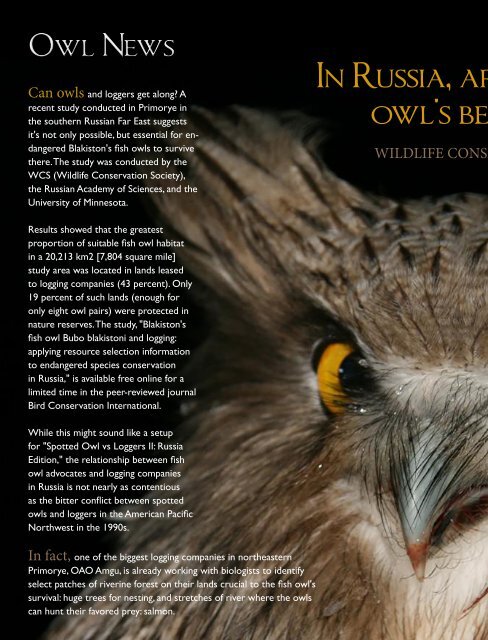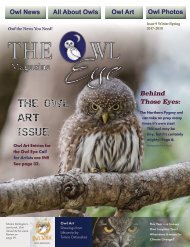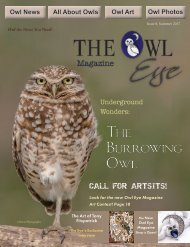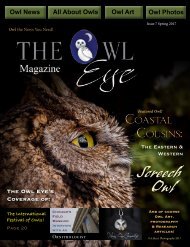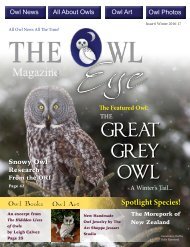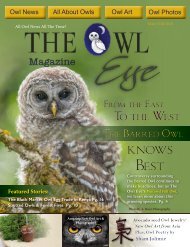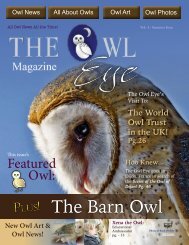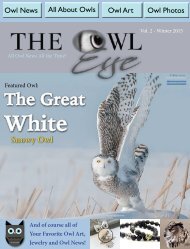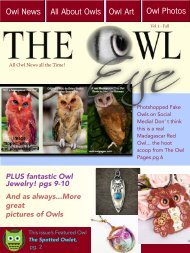owl_eye_online_int
You also want an ePaper? Increase the reach of your titles
YUMPU automatically turns print PDFs into web optimized ePapers that Google loves.
PUBLIC RELEASE: 29-SEP-2015<br />
Can <strong>owl</strong>s and loggers get along? A<br />
recent study conducted in Primorye in<br />
the southern Russian Far East suggests<br />
it's not only possible, but essential for endangered<br />
Blakiston's fish <strong>owl</strong>s to survive<br />
there. The study was conducted by the<br />
WCS (Wildlife Conservation Society),<br />
the Russian Academy of Sciences, and the<br />
University of Minnesota.<br />
Results showed that the greatest<br />
proportion of suitable fish <strong>owl</strong> habitat<br />
in a 20,213 km2 [7,804 square mile]<br />
study area was located in lands leased<br />
to logging companies (43 percent). Only<br />
19 percent of such lands (enough for<br />
only eight <strong>owl</strong> pairs) were protected in<br />
nature reserves. The study, "Blakiston's<br />
fish <strong>owl</strong> Bubo blakistoni and logging:<br />
applying resource selection information<br />
to endangered species conservation<br />
in Russia," is available free <strong>online</strong> for a<br />
limited time in the peer-reviewed journal<br />
Bird Conservation International.<br />
While this might sound like a setup<br />
for "Spotted Owl vs Loggers II: Russia<br />
Edition," the relationship between fish<br />
<strong>owl</strong> advocates and logging companies<br />
in Russia is not nearly as contentious<br />
as the bitter conflict between spotted<br />
<strong>owl</strong>s and loggers in the American Pacific<br />
Northwest in the 1990s.<br />
In fact, one of the biggest logging companies in northeastern<br />
Primorye, OAO Amgu, is already working with biologists to identify<br />
select patches of riverine forest on their lands crucial to the fish <strong>owl</strong>'s<br />
survival: huge trees for nesting, and stretches of river where the <strong>owl</strong>s<br />
can hunt their favored prey: salmon.<br />
In Russia, are loggers an<br />
<strong>owl</strong>'s best friend?<br />
WILDLIFE CONSERVATION SOCIETY<br />
Media Contact<br />
Scott Smith<br />
718-220-3698<br />
@TheWCS<br />
http://www.wcs.org and www.eurekalert.org<br />
Image: this is a blakiston's fish <strong>owl</strong> in primorye,<br />
russia. These massive, endangered <strong>owl</strong>s nest in<br />
cavities of old-growth trees and eat salmon.<br />
Credit: j. Slaght, wcs russia.<br />
"This commitment to fish <strong>owl</strong> habitat<br />
protection by a logging company is<br />
significant," said Sergei Surmach, an<br />
ornithologist at the Russian Academy of<br />
Sciences and a co-author to the study.<br />
"If OAO Amgu and their parent company,<br />
TerneyLes, protect all fish <strong>owl</strong> habitat under<br />
their purview," adds the other co-author<br />
and WCS Russia Projects Manager Jonathan<br />
Slaght, "the number of fish <strong>owl</strong> territories<br />
currently protected in the region would<br />
triple, and result in the protection of nearly<br />
half of all potential fish <strong>owl</strong> home ranges in<br />
our study area."<br />
Another recommendation the study makes<br />
is for logging companies to close unused<br />
logging roads to reduce disturbance to fish<br />
<strong>owl</strong>s and other wildlife. As reported earlier<br />
in the year, TerneyLes has begun working<br />
with WCS to implement such closures in<br />
the region by destroying key bridges and<br />
erecting dirt barricades to block vehicle<br />
passage. These closures minimize illegal<br />
logging and reduce the risk of humancaused<br />
forest fires, while at the same time<br />
keeping poachers away from wildlife.<br />
"We are always looking for ways to balance<br />
the needs of the economy and endangered<br />
species like fish <strong>owl</strong>s," says Surmach. "And<br />
in this case, everybody wins."<br />
Funding for this study was provided by<br />
the Columbus Zoo and Aquarium, Disney<br />
Conservation Fund, Amur-Ussuri Centre<br />
for Avian Biodiversity, National Birds of<br />
Prey Trust, Bell Museum of Natural History,<br />
Denver Zoo, Minnesota Zoo Foundation,<br />
and the National Aviary.


